SERPENT
Dictionary of Mythology: Folklore and Symbols
by Gertrude Jobes
1961
Dictionary of Mythology: Folklore and Symbols
by Gertrude Jobes
1961
Androgyny, circle, convalescence, cunning, danger, death, deceit, destruction, divine emanation, evil, false appearance fertility, guardianship, generation, grief, health, intelligence, jealousy, lasciviousness, malice, materialism, misfortune, phallus, pleasure, power, prophecy, prudence, renewal, revenge, self- creation self -indulgence, self -sustenance sensation, sensuality, sin, subtlety, temptation, treachery, the unfathomable, universe circle, vexations, vice, wiliness, wisdom worldliness. Emblem of lightning, physicians, witchcraft.
Figure used on amulets, or represented by a wavy 'M.' From primeval times revered as the re-embodiment of deceased mortals, most ancient of phallic totem beasts. Assigned to mother goddesses. Form of earth, river, sea, and underworld deities, and rain-withholding clouds. Appears in all tree-worshiping cultures as a weather-controller. In African tradition a dawdler, untrustworthy messenger, but life restorer.
From the legend in which God, angered by man, sent a tortoise with a message of death. Relenting, He sent a snake to overtake the tortoise. The snake loitered on the way, thus man must die first, then he may recover his eternal life.
SERPENT
A Dictionary of Symbols
by J. E. Cirlot / 1971. 385 p.
A Dictionary of Symbols
by J. E. Cirlot / 1971. 385 p.
If all symbols are really functions and signs of things imbued with energy, then the serpent or snake is, by analogy, symbolic of energy itself—of force pure and simple; hence its ambivalence and multivalencies. Another reason for its great variety of symbolic meaning derives from the consideration that these meanings may relate either to the serpent as a whole or to any of its major characteristics—for example, to its sinuous movements, its common association with the tree and its formal analogy with the roots and branches of the tree, the way it sheds its skin, its threatening tongue, the undulating pattern of its body, its hiss, its resemblance to a ligament, its method of attacking its victims by coiling itself round them, and so on.
Still another explanation lies in its varying habitat: there are snakes which inhabit woods, others which thrive in the desert, aquatic serpents and those that lurk in lakes and ponds, wells and springs. In India, snake cults or cults of the spirit of the snake are connected with the symbolism of the waters of the sea. Snakes are guardians of the springs of life and of immortality, and also of those superior riches of the spirit that are symbolized by hidden treasure (17). As regards the West, Bayleyhas suggested that the snake, since its sinuous shape is similar to that of waves, may be a symbol of the wisdom of the deeps (4) and of the great mysteries. Yet, in their multiplicity and as creatures of the desert, snakes are forces of destruction, afflicting all those who have succeeded in crossing the Red Sea and leaving Egypt (57); in this sense, they are connected with the 'temptations' facing those who have overcome the limitations of matter and have entered into the realm of the 'dryness' of the spirit.
This explains why Blavatsky can say that, physically, the snake symbolizes the seduction of strength by matter (as Jason by Medea, Hercules by Omphale, Adam by Eve), thereby providing us with a palpable illustration of the workings of the process of involution; and of how the inferior can lurk within the superior, or the previous within the subsequent (9). This is borne out by Diet, for whom the snake is symbolic not of personal sin but of the principle of evil inherent in all worldly things. The same idea is incorporated into the Nordic myth about the serpent of Midgard (15). There is a clear connection between the snake and the feminine principle.
Eliade observes that Gresmann (Mytische Reste in der Paradieserzahlung in Archiv f. Rel. X, 345) regarded Eve as an archaic Phoenician goddess of the underworld who is personified in the serpent (although a better interpretation would be to identify it with the allegorical figure of Lilith, the enemy and temptress of Eve). In support of this, Eliade points to the numerous Mediterranean deities who are represented carrying a snake in one or both of their hands (for example, the Greek Artemis, Hecate, Persephone), and he relates these to the finely sculpted Cretan priestesses in gold or ivory, and to mythic figures with snakes for hair (Medusa the Gorgon, or the Erinyes). He goes on to mention that in Central Europe there is a belief that hairs pulled out from the head of a woman under the influence of the moon will be turned into snakes (17).The serpent (or snake) was very common in Egypt; the hieroglyph which corresponds phonetically to the letter Z is a representation of the movement of the snake. Like the sign of the slug, or horned snake (phonetically equivalent to F), this hieroglyph refers to primigenial and cosmic forces. Generally speaking, the names of the goddesses are determined by signs representing the snake—which is tantamount to saying that it is because of Woman that the spirit has fallen into matter and evil. The snake is also used, as are other reptiles, to refer to the primordial—the most primitive strata of life. In the Book of the Dead (XVII), the reptiles are the first to acclaim Ra when he appears above the surface of the waters of Nou (or Nu or Nun).
The demonic implications of the serpent are exemplified in Tuat, whose evil spirits are portrayed as snakes; however, these— like the vanquished dragon—may also take on a beneficent form as forces which have been mastered, controlled, sublimated and utilized for the superior purposes of the psyche and the development of mankind, and in this sense they correspond to the goddesses Nekhebit and Uadjit (or Buto). They also become an Uraeus—the same thing happens in the symbolism of the Kundalini—constituting the most precious ornament of the royal diadem (19).
SERPENT
Dictionary of Symbols and Imagery
by Ad de Vries / 1976. 515 p.
Dictionary of Symbols and Imagery
by Ad de Vries / 1976. 515 p.
A. general:1. there is a general confusion with 'Snake': even though in biology the term 'serpent' is usually preferred for the larger kinds, literature has never made that distinction; therefore Snake and Serpent have been put under one heading; the other distinctives (viz. the serpent being limbless, having scales, and being characterized by hissiny and stinging) are not observed either: e.g. in old prints of the Paradise-scene the 'serpent' does have limbs, looking more like a lizard, or (even likelier) a 'dragon'; only when specific mention has been made of the kind, e.g. Adder (which itself has been mixed up with Asp), or Viper, it has been given under a separate heading;
2. as the serpent represents any primeval, cosmic force, it shares the ambiguity of all ancient, elementary symbols (cf. Eagle, Lion, etc.); examples: a. the most spiritual of all creatures; it has a fiery nature, and its swiftness is terrible; it has a long lite (yearly renewed); b. it is also the most earthy animal, cold-blooded, unconscious, unrelated; c. it is both toxic and prophylactic; d. as 'Agathadaimon' it is both a good and a bad 'daemon'; e. Gnostic: emblem of the brain-stem and spinal chord, consistent with its predominantly reflex psyche; v. Q. 1; f. it is the symbol for the unconscious, expressing the latter's sudden manifestation, its painful and dangerous intervention in our affairs (thus being a manifestation of the unconscious mother-image), so: feminine; but also the phallic symbol, so: masculine;
3. as 'dragon' it is often 'plumed', 'winged' (cf. Basilisk), or 'horned';
4. it is androgynous: selt: creative (like Lotus, Scarab, etc.);B. divine emanation:I. O.T.:the relation between Moses' "Brazen serpent" and Yahweh's "Brazen serpent" and Yahweh is highly ambiguous; v. Seraph;
II. Greek:1. Zeus:a. to escape Cronos he changed into a serpent, and his guards into bears, both of which are seen as constellations (and are seasonal animals);b. he coupled with Rhea, his mother, who had taken refuge in the form of a snake, by taking the same form and becoming an 'insoluble knot' with her;c. v. H, IV;2. in the Pelasgian Creation-myth Eurynome, the Goddess of All Things, rose naked out of Chaos, caught hold of the North Wind (Boreal), rubbed it between her hands, and the great serpent Ophion was created, who fertilized her (tor Boreas as fertilizer: v. also Horse);
3. it is an attribute of Dionysus (as fertility- god); he was crowned with serpents (i.e. born in winter: v. Seasons);
4. it is sacred to Agathadaemon, Apollo, Asclepius, Athena, Erichthonius; the serpent from which the staff of Apollo Belvedere is made, represents Omphalos (v. Navel), from which umbilicus was derived;III. Norse:1. Odin disguised himself as a snake (also as an eagle, its opposite: cf. Zeus), and so did Loki;
2. this may explain the serpent-forms on Germanic swords, e.g. the sword with which Beowulf killed Grendel's mother; also in the O.K. poem "The Wanderer" (a minstrel repenting old tunes): "Now in the place of the dead warriors stands a wall, wondrous high, covered with serpent-shapes" which thus may refer to gods (or, less likely, to dead souls)IV. sun (god):1. a snake expresses sun-rays (another link with sword);
2. in a complete circle it represents the Zodiac (beside Eternity); Macrobius: the curving movement of the sun;3. the serpent was used by the Egyptians in nearly all symbols, but mainly the sun-symbol: it even formed part of the hair-style of Isis; v. N, 1C. evil:1. the inferior inhabiting the superior, evil inhabiting everything;
2. for Yahweh conquering the 'monster of the deep': v. Chaos;
3. as Satan: tall trom Divine Grace;
4. if the snake in itself is already magically potent, the coupling of two, seen by human eyes, is fatal: v. the myth of Tiresias: it brings blindness with either homosexuality or change of sex: ref. Ovid (Metam. 3, 323ff.);
5. Germanic: a gigantic serpent (with lesser snakes) nibbles at the root of the Tree of Life, Yggdrasill; the WorldSerpent is Loki's childD. Life, healing:1. Life: a. connected with the wheel of life: v. Ouroboros; b. sacrificed: killing the serpent (= life-force) = to accept death (cf. the swan who wafts the hero to heaven); c. fertility: after Python had coupled with Eurynome (v. B, 11, 2) she bashed his head, kicked out his teeth, and sent him underground (the source of riches), when he claimed authorship of the Universe; yet from his teeth man had sprung; d. Germanic: Balder was rendered invincible by a food over which snakes had dropped poison;
2. healing:a. the Brazen Serpent of Moses: erected by him after the 'visitation' of the 'fiery serpents' (serafim): those who looked upon it were cured (later the practice was recognized as idolatrous and discarded); thus the serpent was punishment and healing at once; in Hezekiah's time it was called Nehushtan: nehoshet (= brass) + nahash (= snake);
b. Aesculapius (Apollo's 'son') visited the disease-stricken country of the Romans (at their bidding) in the form of a crested snake, going before them from the temple in Epidaurus to their ships, and guiding the ship with his head on the stern: Ovid (Metam. 15, 626fT.); v. also Caduceus (e.g. for the physician's emblem) andE. eternity, fertility, regeneration:I. eternity:1. v. Ouroboros: a snake biting its own tail, making a circle;2. in Babylonian myth the thief who steals the plant of immortality from Gilgamesh is a snake;II. fertility:1. it is often coiled around a person to give generative heat: Aion, the Egg of the World, Buddha, etc.;
2. in the Adonis-myth the part of the year he spends with Persephone is represented by a snake (winter);
3. on the love-bed of Queen Titania was shed a snake's "enamelled skin, Weed wide enough to wrap a fairy in": MND 2, 1III. regeneration:1. it sheds its skin;
2. Babylonian: the earth-god E a-En-ki (in serpent- form) gave man knowledge of the World's Order, but made death necessary, so he could rise again;
3. Iightning (apart from fertility) is a sign of the birth of a new Cycle (v. Thunder);
4. the marrow of a dead man's spine becomes a snake: v. Q, 1, and Spine; v. also E, 1, 2F. earth, underworld:1. incarnation of the dead;
2. the world-snake of 'Midgard', biting its own tail, also stands tor the ocean which encircles the earth, and is the place where the sun makes its Night- crossing (= the Underworld); his movement causes the sea-storms; at the Twilight of the Gods he fought (and was vanquished by) his great enemy Thor;
3. the winds are represented as having serpents' tails: coming from the ground (the wind-mountain), so chthonian, in charge of the White Goddess (and later the witches), or Aeolus; it may also refer to the tapering of their strength;
4. Eros was originally a chthonic snake, a Lord of the Underworld, where death-resurrection took place: v. the myth of Eros and Psyche;
5. as psychopomp: "As it fell upon a day Rich Dives sickened and died; Then came two serpents out of hell, His soul therein to guide"
SERPENT
The Continuum Encyclopedia of Symbols
by Udo Becker / 1994. 343 p.
The Continuum Encyclopedia of Symbols
by Udo Becker / 1994. 343 p.
Among most peoples, the serpent plays an extraordinarily important and extremely diverse role as a symbolic animal. The primary characteristics that gave the serpent its symbolic significance were the special place it occupies in the animal kingdom (movement over the ground without legs, living in holes in the ground, yet slipping out of eggs like a bird), its cold, slick and shiny exterior, its poisonous bite and its venom that can be used for medicinal purposes, as well as its periodic shedding of its skin.
It is frequently encountered as a chthonic being, as an adversary of man (but also as an apotropaic animal), as a protector of sacred precincts or of the underworld, as an animal having the soul of a human, as a sexual symbol (masculine because of its phallic shape, feminine because of its engulfing belly), and (because of its shedding) as a symbol of constant power of renewal.
In Africa, the serpent was occasionally revered in cults as a spirit or deity.
In ancient Central American civilizations, the feathered serpent, in particular, played a large role; it was originally a symbol of rain and vegetation and later became a "night sky serpent covered with green quetzal feathers" that stood opposite the "turquoise serpent or day sky serpent" and, united with the latter, represented a symbol of the cosmos.
In China, the serpent was thought to be connected with the earth and water and was thus a Yin symbol. In Indian mythology, there are nagas, serpents that function as beneficent or maleficent mediators between gods and humans and were sometimes (like other serpents in other civilizations) associated with the RAINBOW. The kundalini serpent, imagined as being rolled up at the bottom end of the spine, is regarded as the seat of cosmic energy and is a symbol of life and (psychologically formulated) libido.
The oldest evidence for a staff of Aesclepius comes from Mesopotamia (end of the 3rd millenium B.C.). In the symbolism of the Egyptians, the serpent played an essential and greatly varying role; there were, for example, several serpent goddesses, such as a cobra goddess who presided over the growth of plants. Fate (good or bad) was also sometimes worshipped in the form of a serpent, that is, as a "house spirit."In addition, there are numerous mythological serpents (winged, with feet, many-headed). The uraeus serpent was regarded as a representative of a goddess who had many names; in it, one saw the embodiment of the eye of the sun god; according to mythology, it rises up on its tail end on the sun or on the forehead of the sun god and destroys its enemies with a breath of fire; its likeness appears on the forehead of Egyptian kings as a symbol of protection and rulership. Apophis, the arch-foe of the sun god and of world order, is also in the form of a serpent.
In addition, the symbol of the UROBOROS, the serpent biting its own tail, first appeared in Egypt.
The Jews considered the serpent primarily as a threatening creature; the Old Testament counts it among the unclean animals; it appears as the idealized image of sin and of Satan and is the seductress of the first couple in Eden; on the other hand, though, it also appears as a symbol of prudence. When God punished the disobedience of the Israelites with a plague of poisonous, winged serpents, He commanded Moses, who asked for help, to make a BRAZEN SERPENT; whoever was bitten by poisonous serpents and looked upon the brazen one, was to remain alive. Thus, a Brazen Serpent of this type was long a ritual object of the Jews and was considered by Christianity to be a symbolic portent of Christ due to its salutary character; the serpent figures on bishops' crooks refer in part to that Brazen Serpent as well as to the serpent as a symbol of prudence.
There were numerous mythological and symbolic serpent figures in antiquity as well, frequently in the form of monstrous hybrid creatures (see CHIMERA; ECHIDNA; HYDRA). In the cult of the god of healing, Asclepius (Aesculapius), the serpent (with respect to its shedding of its skin) played an important role as a symbol of the constant self-renewal of life (see ASCLEPIUS, STAFF OF). Serpents were often kept in Roman houses as symbols of house and family spirits. The Midgard Serpent of Old Norse mythology is a giant, destructive serpent that closely surrounds the earth (Midgard), which is thought of as a disk; it is a symbol of constant threat to the world order; in early Christianity, it was identified with LEVIATHAN.Christian art of the Middle Ages often emphasizes the seductive aspect of the serpent of Eden by a close association with woman (such as depictions of serpents having a woman's head and breasts), whereby an inner relation to the tempted Eve is suggested. In PHYSIOLOGUS, the serpent is discussed with respect to the text of Matthew 10:16, "Be ye therefore wise as serpents, and harmless as doves."
The serpent is the sixth sign of the Chinese ZODIAC and corresponds to Virgo (see VIRGIN).
SERPENT
Symbolism: A Comprehensive Dictionary
by Steven Olderr / 1986. 153 p.
Symbolism: A Comprehensive Dictionary
by Steven Olderr / 1986. 153 p.
serpent evil; sin; energy; force; night; subterranean life; fertility; wisdom; power to heal; generative energy; regeneration; the Devil; secrecy; hiding; danger; death; materialism; slavery; temptation; fascination; jealousy; wisdom of the deep; guardian of the springs of life, immortality, the superior riches of the spirit; great mysteries; forces of destruction; seduction of strength by matter; the inferior within the superior; the evil inherent in all worldly things; the evil side of nature; the feminine principle; a phallic symbol; the unconscious expressing itself suddenly and unexpectedly with terrible or frightening results;
emblem of the tribe of Dan; attribute of Saturn, Janus, Father Time, Asclepius, Minerva, Ceres, St. Patrick, the personifications of Time, Earth, Logic, Innocence, Africa heraldry strategy; military fame; courage; vigilance; instinct; the subconscious China evil; cunning horned snake water; intensified duality; opposite forces in conflict feathered snake duality (good / evil, heaven / earth, etc.) brass snake associated with the Crucifixion snake with head erect human wisdom ~ rising snake retrospection snake in a circle, or biting its own tail eternity; time; union of the sexes (has to have its tail in its mouth); the zodiac snake encircling a globe the spread of sin; the omnipresence of sin snake encircling a tree the Fall of Man woman holding a mirror and a serpent Prudence personified serpent at the foot of the Cross Christ's overcoming of the evil that leads man into sin plumed serpent beneficence; reconciliation of opposites;the angel of dawn serpent with sheep's head spring; initiation; spiritualization serpent with rod or staff the miracles of Aaron, Moses serpent over a fire associated with St. Paul at Melita twin serpents death; all binary opposites (good / evil, male / female, life / death, etc. ) three coiled snakes attribute of St. Hilda serpent sloughing its skin rebirth; healing; kissing a serpent's head; fellatio serpent on a Tau cross; Christ ;the Virgin Mary; with a serpent underfoot victory of the Seed of Woman bruised serpent; attribute of the Virgin Mary indicating her victory over sin serpent battling with a fish Satan tempting Christ; serpent emerging from a cup or chalice the attempted poisoning of St. John; serpent on a sword attribute of St. John; serpent in a loaf of bread or in other food attribute of St. Benedict; woman with serpents for hair Medusa; woman with serpent to breast Cleopatra; woman treading on serpent; the Persian sibyl; serpent entwined around a woman's arm or leg;
Eurydiceù serpent with a woman's head Deceit personified serpent entwining a corpse, with other victims nearby Cadmus two youths and a man wrestling with a serpent Laocoon and his sons infant wrestling with two serpents; Hercules man shooting python with arrows; Apollo image of a serpent with a human head on a shield; attribute of the Iron Age personified; serpent around man's wrist at campfire; St.Paul; serpent with infant in a basket; Erichthonius; see also viper; wyvern; sea serpent; python
The letter S was one of the oldest symbols of serpenthood, both in its shape and in its sibilant sound; and the serpent was one of the oldest symbols of female power. Woman and serpent together were considered holy in preclassic Aegean civilization, since both seemed to embody the power of life. Serpents were considered immortal because they were believed to renew themselves indefinitely by shedding old skins. It was the mother of all gods, the Earth Goddess Gaea, who first founded the Delphic ("Womb") oracle and inspired its original Pythonesses or divinatory serpent-priestesses, according to Homeric hymns. Hesiod referred to her as Gaea Pelope, the female serpent.
The biblical Nehushtan was a deliberate masculinization of a similar oracular she- serpent, Nehushtah, Goddess of Kadesh (meaning "Holy"), a shrine like that of the Pythonesses. Israelites apparently violated the sanctuary and raped its priestesses, but "Moses and Yahweh had to placate the angry serpent goddess of Kadesh, now deposed, by erecting her brazen image.... Mythologically, the serpent is always a female divinity."
In India, the "Mother of All that Moves" and Goddess of the Earth sometimes bore the title of Sarparajni, "Serpent Queen." As the female serpent Ananta the Infinite, she enveloped all gods during their death-sleep between incarnations. As the female serpent Kundalini, she represented the inner power of the human body, coiled in the pelvis like woman's organs of life-giving. It was, and still is, the aim of male Tantric sages to awaken the female Kundalini serpent in their own bodies, through physical, mystical, and sexual exercises and through meditation on the female principle.
Among the oldest predynastic Goddess figures in Egypt was the serpent-mother Iusaset, or Ua Zit, or Per-Uatchet whom the Greeks called Buto. Pyramid Texts say she is the Celestial Serpent, giver of the food of eternal life. 3 Her symbol, the uraeus, meant both "serpent" and "Goddess." She was also Mehen the Enveloper, the female serpent like Ananta who enclosed the phallus of Ra the sun god every night. There are mythic indications that this nightly sexual communion with the serpent power of Mother Earth was at times considered the real source of Ra's renewed power to light up the world again each day.
The Middle East used to regard the female serpent as the embodiment of enlightenment, or wisdom, because she understood the mysteries of life. In Arabic, the words for "snake," "life," and "teaching" are all related to the name of Eve-the biblical version of the Goddess with her serpent form, who gave the food of enlightenment to the first many Of course, in the Bible both Eve and her serpent were much diabolized; but Gnostic sects of the early Christian era retained some of the older ideas about their collaboration concerning the fruit of knowledge. Some sects worshiped the snake as a benevolent Female Spiritual Principle, who taught Adam and Eve what they needed to know about God's duplicity, saying,"You shall not die; for it was out of jealousy that he said this to you. Rather, your eyes shall open, and you shall become like gods, recognizing evil and good."The "arrogant ruler" (God) cursed the woman and her snake, declaring that they must be enemies to one another instead of collaborators.6 But the Gnostics honored Eve and the serpent for providing the essential knowledge that made human beings human.
Naturally, the serpent was also masculinized and often viewed as Eve's first consort. Gnostics called this serpent Ophion, or the Aeon of Light, or Hellos, or Agathodemon, which meant the Great Serpent of Good, as opposed to Kakodemon, the Great Serpent of Evil.7 His worshipers were sometimes known as the Brotherhood of the Serpent. Their writings said: "Thou who risest from the four winds, thou friendly good demon, glittering Hellos, shining over the whole earth, thou art the great serpent who leadest the gods."
Several other mythologies also had the Tree of Life or Tree of Knowledge guarded by a serpent sacred to the Goddess, such as Ladon, the mighty serpent who guarded Mother Hera's life-giving apple tree in the Garden of the Hesperides. The intimate relationship between the Goddess and her serpent consort was believed to be the reason for his deathlessness. Gnostic mysticism turned the Great Serpent into Ouroboros earth dragon living forever in the uterine underworld. A symbol of his cosmic world-creating seed was the round sea urchin, which the Celts called "serpent's egg."9 Some showed Raphael as a Wise Serpent.
Christians adopted the Great Serpent as a form of their devil; yet the life-giving powers of the serpent retained popularity in secret books of magic and materia medica. As late as the eighteenth centuryA.D., Arnold de Villanova declared that stags are known to reverse of old age and restore their youth simply "by feeding on vipers and serpents."
SERPENT
Symbols, Our Universal Language
by Eva C. Hangen / 1962. 308 p.
Symbols, Our Universal Language
by Eva C. Hangen / 1962. 308 p.
From the serpent we get a great variety of symbolisms, among them:
In general symbolism, good, evil, wisdom, power, eternity, everything that is base, dark, low, depending upon the circumstances into which the reptile is drawn.From Matthew 10:16, symbol of wisdom
Serpent surrounding a tree, fall of man.
Serpent wrapped around a globe, spread of sin.
A serpent coiled when held aloft upon a staff, regeneration.
Coiled with head erect, defiance.
With tail in its mouth, eternity or temptation.
Man-headed with double tail, fraud.
Serpent drinking from a kantharos in hand of a maiden, (Hygeia) health.
SERPENT
A Dictionary of Symbols
by Jean Chevalier and Alain Gheerbrant / 1994
A Dictionary of Symbols
by Jean Chevalier and Alain Gheerbrant / 1994
Serpents are as different from all animal species as the human race, but at the opposite end of the scale. If mankind may be regarded as standing at the end of a long evolutionary struggle we must set this cold-blooded, armless, hairless, featherless creature at its very beginning. In this sense mankind and serpents are opposites, complementary and rivals the one to the other. In this sense too, there is something of the serpent in all human beings, and strangely enough in that portion of them over which they have the least control. An analyst has remarked that 'the serpent is a vertebrate creature embodying the lower psyche, hidden psychosis and what is unusual, incomprehensible and mysterious.' There is nothing so simple or so commonplace as a serpent, and yet by virtue of this very simplicity nothing which shocks the spirit more.
At the well-springs of life: the serpent as soul and libido
Travellers in the southern Cameroon's have observed that in their hunting language the Pygmies depict serpents as a line on the ground and doubtless similar cave-drawings have exactly the same meaning. They may be said to take the serpent back to its original manifestation. It may only be a line, but it is a living line, what Andre Virel calls 'an abstraction in flesh and blood'. Lines have neither beginning nor end and, once they come alive, they become capable of depicting whatever you like or of changing into any shape. All that can be seen of the line is what is immediately made manifest in space and time, and yet one is aware that, at either end, it is produced into invisible infinity.
The same is true of the serpent. When made visible on Earth, the serpent in the instant of its manifestation is the sacred made manifest. Above and beyond this, there is a feeling that it is a continuation of the infinite materialization which is none other than primordial formlessness, the storehouse l latency which underlies the manifest world. The serpent which we see is . he manifestation of the holiness of nature, a holiness which is material and no sense spiritual. It makes its appearance in the sunlit world like a ghost which one can touch, but which slips through one's fingers. So, the serpent evades time which can be clocked, space which can be measured and logic which can be rationalized, to escape to the lower reaches from which it came and in which it can be imagined timeless, changeless and motionless in the fullness of its life. Swift as lightning, the serpent streaks from the dark mouth of some crevice or cranny to vomit life or death, before returning again to invisibility. Or else the serpent discards its male appearance to become female, coiling up, entwining around, squeezing, throttling, swallowing, digesting and sleeping.
The she-serpent is the invisible serpent principle which dwells in the lower levels of consciousness and the deeper strata of the Earth. It is secret and equivocal, its decisions are unpredictable and as swift as its transformations. Ever ambivalent, it toys with its own sexuality; it is both male and female, twins within the same body, like so any of the culture- heroes who are always depicted initially as cosmic serpents. The serpent does not therefore depict an archetype but an archetypal complex, linked to the freezing, clammy subterranean darkness of the beginning of things.
'All possible snakes together form one single primordial manifoldness, an inseverable primordial Something which yet is ever coiling and uncoiling, which is ever melting away and re-emerging' (KEYM p. 222). Yet what is this 'primordial Something' if it is not latent life or, as Keyserling puts it, 'the lowest layer of life'? It is the well-spring, potentiality, from which all manifestation derives. 'Nethermost Life', he continues, 'must needs be reflected in daylight consciousness in the form of a snake as indeed the Chaldeans had but one word for Serpent and Life' (KEYM p. 21). Rene Guenon makes the same observation: 'Serpent symbolism is, in fad, linked to the notion of life itself. In Arabic the word for "serpent" is el~hayyah, and that for "life", el-hayat' (GUES p. 159), adding, and this is of prime importance, that El-Hay, one of the principal names of God, 'should not be translated as "the Living", but as "the Life-giving", the one who bestows life or who is the principle of life itself.'
The serpent which we see should, therefore, be regarded simply as a eeting incarnation of a Great Invisible Serpent, causal and a-temporal, lord of the life-principle and of the powers of Nature. The serpent is an 'Old God', the first god to be found at the start of all cosmogenesis, before religions of the spirit dethroned him. He created life and sustained it. On a human level he is the dual symbol of soul and libido. 'The serpent is one of the most important archetypes of the human soul', wrote Bachelard (BACR p. 212). In Tantrism, the serpent is the kundalin', coiled round the base of the spinal column, on the sleep-state chakra, 'its mouth closes the urethral meatus' (DURS p. 343). When the serpent awakes, hisses and stiffens, ascent through the successive chakra takes place. This is the rising tide of the libido the fresh manifestation of life.
The Book of Symbols
by Jana Garai / 1974. 143 p.
by Jana Garai / 1974. 143 p.
"The infernal serpent; he it was,
whose guile,
Stirr'd up with envy and revenge, deceived
The mother of mankind'.
Stirr'd up with envy and revenge, deceived
The mother of mankind'.
Paradise Lost
John Milton
John Milton
SNAKE
FROM BABYLON to Greece, India and China to Europe, the eternal symbol of the snake crossed every path in the myth, culture and history of man. As the Egyptian Ra arose from the depth of the primeval water of Nun, the snake was the first to acclaim him god. In the shape of the great serpent Ophion, he entwined the divine limbs of the Greek Great Goddess and feathered the earth. An ally of monsters as well as the gods, he was the inspiration of the Nassenes and is still a source of of ecstasy to the Holy Rollers of Kentucky.
The wisdom of the gods was the knowledge of the serpent; his sinuous form like the undulating waves of the sea which contain every secret and the mystery of life. Melampus, whose ears were licked by snakes, was the first mortal to be granted prophetic powers and to learn the language of the birds and insects. Garga, the father of Indian astronomy, owed his learning to a serpent. The god Quetzalcoatl, master of life, patron of the arts, and snake-bird, taught agriculture, metallurgy and gave the Aztecs maize and freedom from disease. Plutarch concluded that the serpent himself was a deity because 'it feeds upon its own body; even so all things spring from God, and will resolve into deity again'. The ouroboros, a symbol of the snake biting his own tail, was at the time adopted by the Gnostics, not only because it was a deity, but also because it represented the 'circle' or the 'wheel' of life, regeneration and eternity. The ability of the snake to shed its skin was confirmation of the belief in resurrection to the ancient sages and they thought that with its skin, it also shed old age.
As a symbol of evil the coiled serpent of Midgard encircled the earth in the mythologies of the Noresemen. A serpent entwined the Tree of Life in the Garden of Paradise and first whispered the words of corruption to Eve. The woman succumbed and, like Hecate and Artemis who carry the snake in their hands or the grotesque Medusa whose tresses are made of reptilian coils, the shadow of sin endangered the spirit. The snake or the Devil lurks in the darkness to challenge the power of good; it is a symbol of seduction and the inherent evil in all the things of the world. But the snake coiled also around the caduceus of Mercury and the staff of Aesculapius, the god of medicine and healing. As good is balanced by evil, so must health be offset by sickness, and the brass serpent of Moses was the healer of the wound caused by the serpent.
The coiled or triumphant serpent had to be vanquished; so the body of a snake nailed to a cross is found in the sixteenth century book of Abraham le Juif. There it is taken to mean the conquest of the spirit over the temptation of the woman and is also an undeciphered symbol of the union of the male and female principle in alchemy. In the Iliad, an eagle carrying a wounded snake in its claws appears to the Greeks. The crucified serpent is again symbolic of the triumph of the patriarchal Aryans, who have subdued the feminine and matriarchal tradition of Asia.
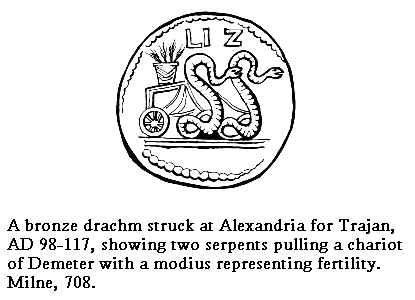
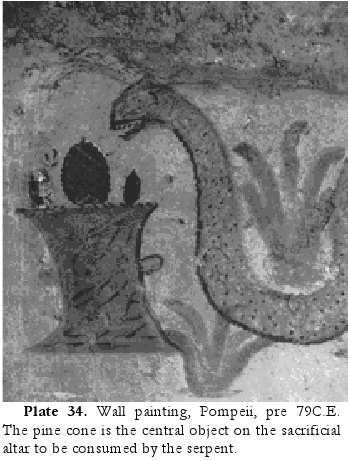
Pine cone http://forum.davidicke.com/showthread.php?t=16102&page=26

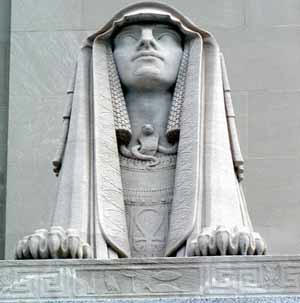
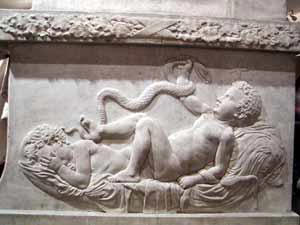
George Washington Masonic Memorial in Alexandria, Virginia.
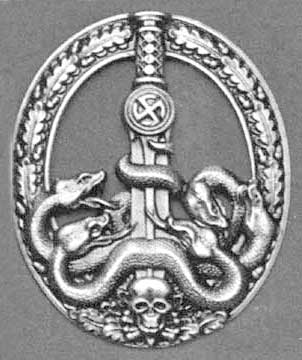
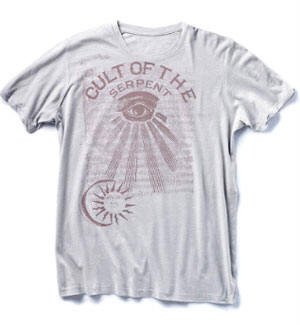
"Cult of the Serpent" tee shirt being sold at Macy's department stores.
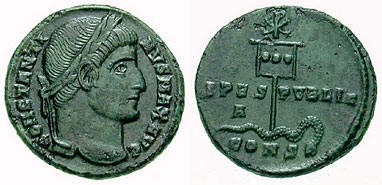
Chi Rho/PX. A coin of Constantine (c.337) showing a depiction of his labarum spearing a serpent.
Masonic
Quotes
"The Serpent is universally esteemed a legitimate symbol of Freemasonry." George Oliver, Signs and Symbols , New York, Macoy Publishing and Masonic Supply Company, 1906, p. 36
"The serpent is the symbol and prototype of the Universal Savior, who redeems the worlds by giving creation the knowledge of itself and the realization of good and evil." Manly P. Hall, 33 Degree Mason, The Secret Teachings of All Ages
"The serpent entwined around the egg, was a symbol common to the Indians, the Egyptians, and the Druids. It referred to the creation of the Universe." pg. 496; Teaching of the 25 Degree, Knight of the Brazen Serpent
"... our mode of teaching the principles of our profession [Masonry] is derived from the Druids ... and our chief emblems originally came from Egypt ..." William Hutchinson, Mason, The Spirit of Masonry
"The Druids had a high veneration for the Serpent. Their great god, Hu, was typified by that reptile; and he is represented by the Bards as 'the wonderful chief Dragon, the sovereign of heaven'." George Oliver, Signs and Symbols, New York, Macoy Publishing and Masonic Supply Company, 1906, p. 36
"Masons .. admire the Druids and some of them even claim that Masonry came from Druidism. Of course, the Druids were occultic priests, practiced astrology, and offered human sacrifices." Dr. C. Burns, Masonic and Occult Symbols Illustrated, p. 28
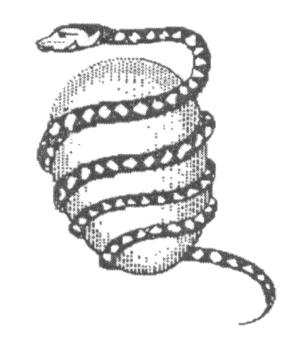
"The serpent entwined around the egg, was a symbol common to the Indians, the Egyptians, and the Druids. It referred to the creation of the Universe." [p. 496; teaching of the 25 Degree, Knight of the Brazen Serpent ] http://www.cuttingedge.org/free15.htm


George Washington Masonic Memorial in Alexandria, Virginia.
Gods
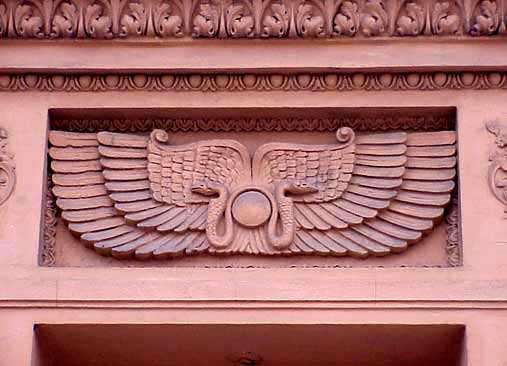
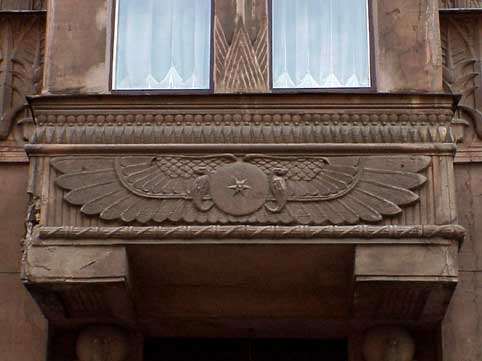
Quetzalcoatl
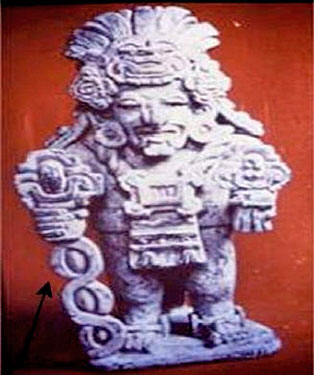
Caduceus Statue of Quetzalcoatl with entwined snakes around a rod
Horus [Horus]
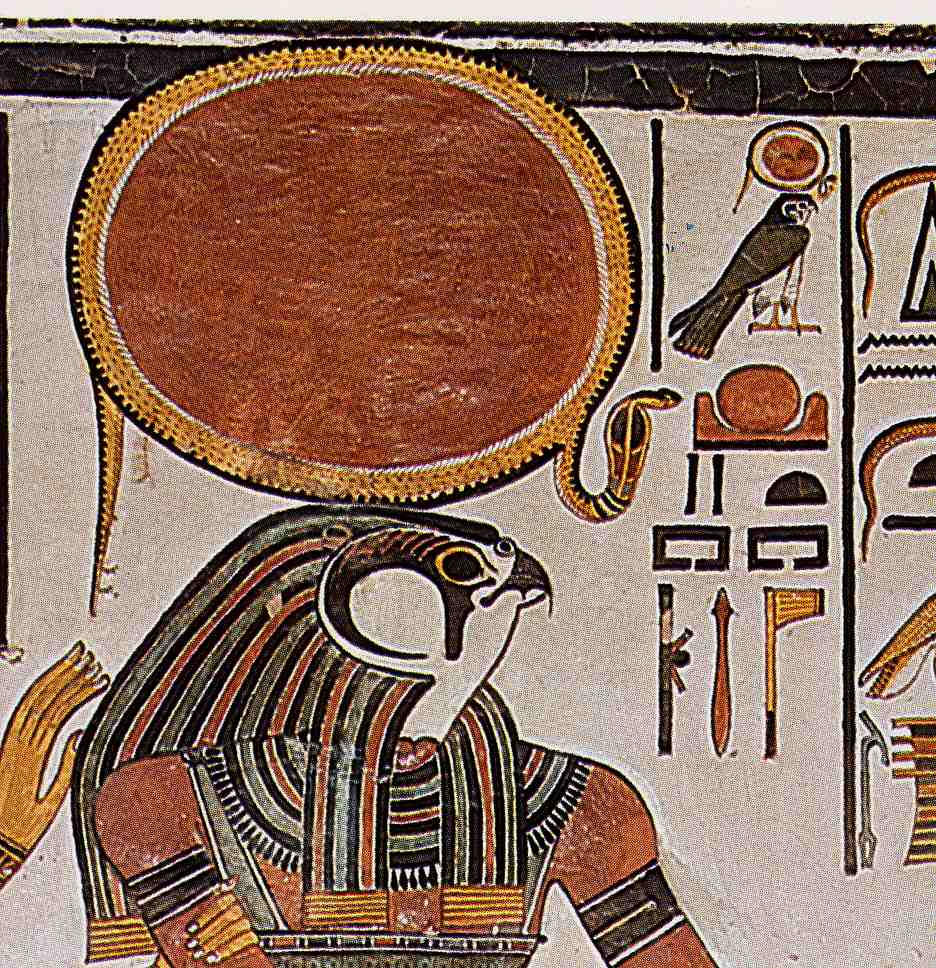
Thoth
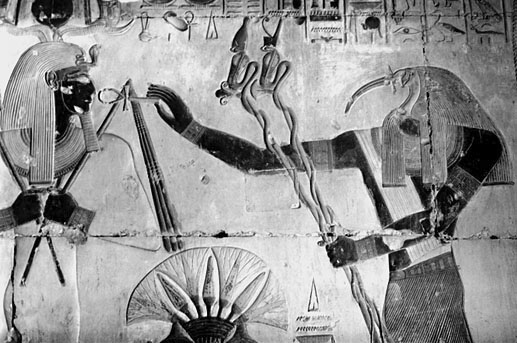
Apep [Apep]
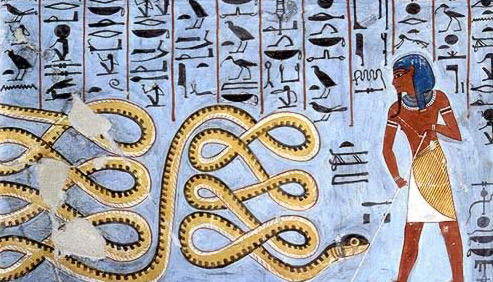
Ningishzidda [Ningishzidda]
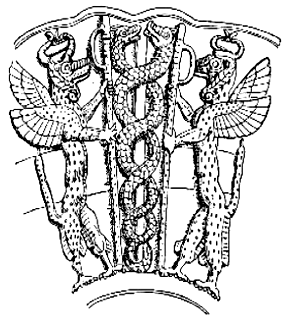
Seal of Ningishzidda as entwined snakes around a rod
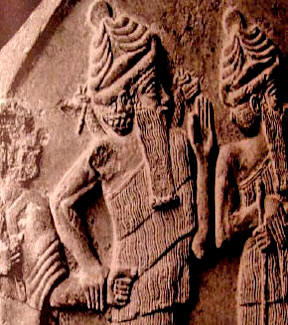
Ningishzidda in human form with horned snakes on his shoulders
Hecate [Hecate]
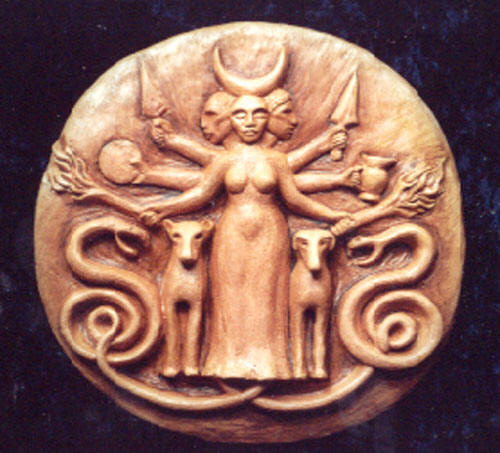
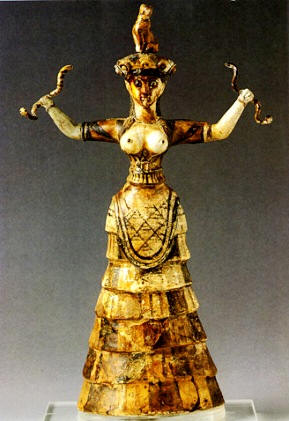
Mithras [Mithras]
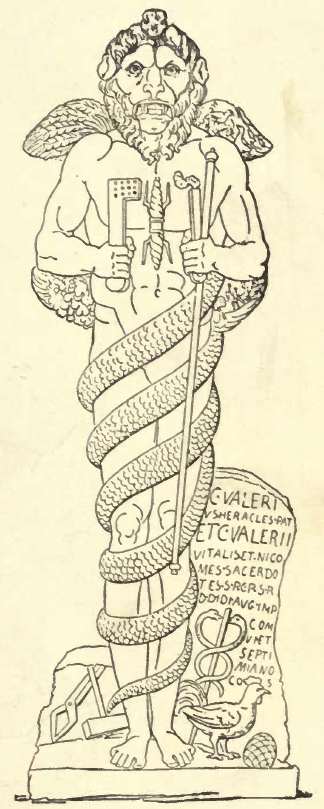
Hermes [Hermes]
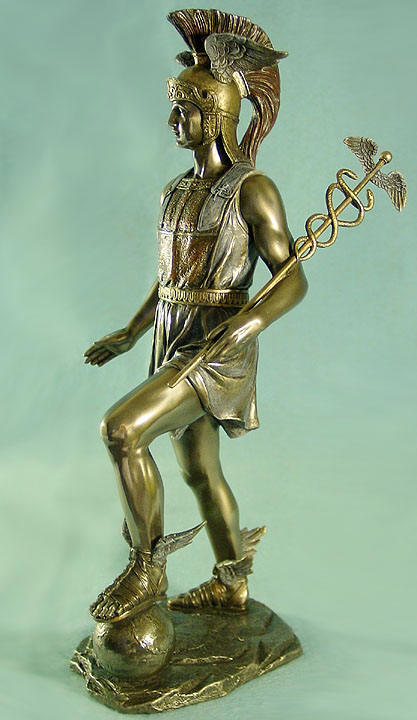
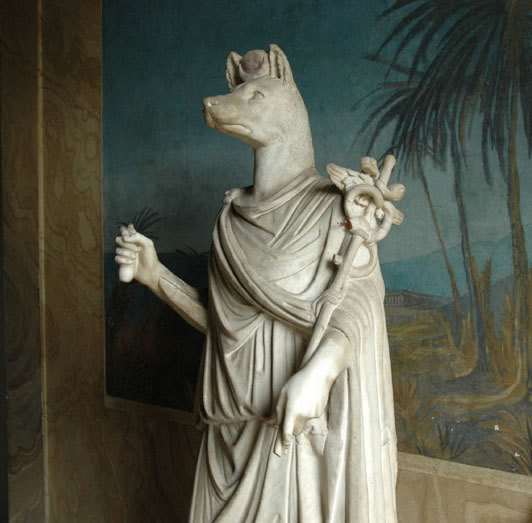
Hermanubis, Greco-Egyptian syncretic diety (Hermes+ Anubis...)
Dionysus [Dionysus]
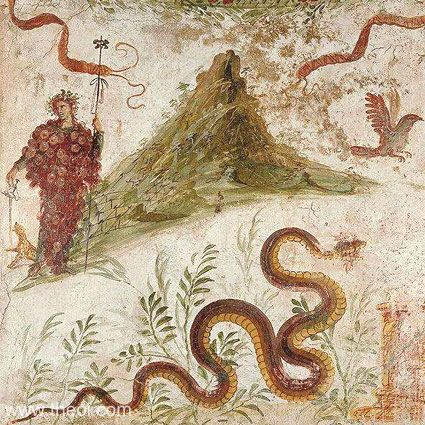
Dionysos stands beside Mount Vesuvius, with a leopard cub by his side, and coiling serpent.
Athena [Athena]

Astaroth [Astaroth]
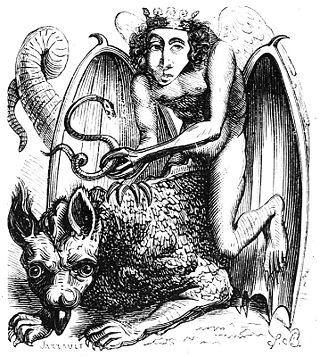
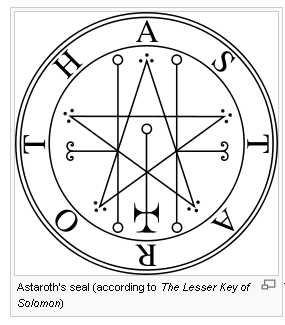
Wings Snake Dragon Pentagram
Gorgon [Gorgon]
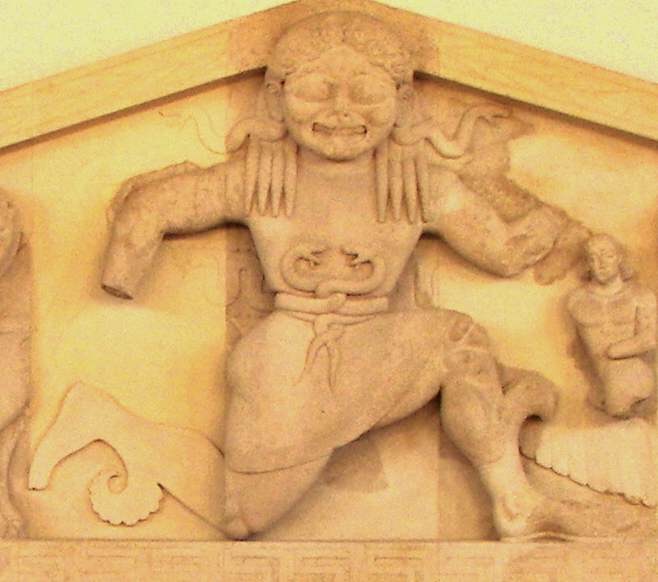
Saturn [Saturn Arm and Hammer]
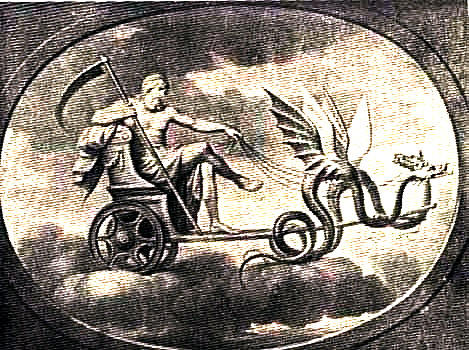
Cecrops, founder of Athens, Greece.

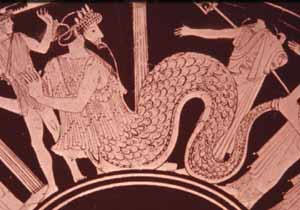
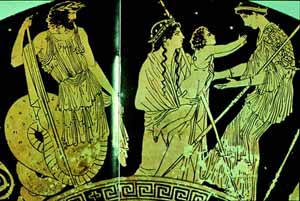
Kali [Kali]
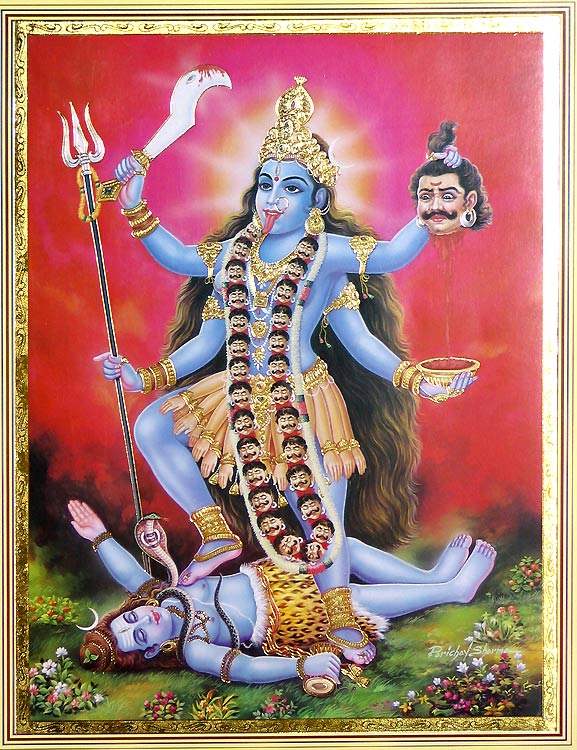
Shiva [Shiva]
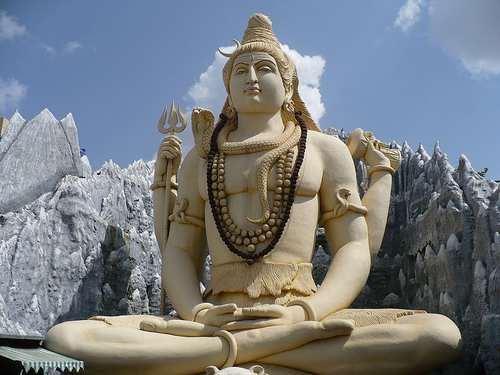
Antichrist comes from the tribe of Dan


